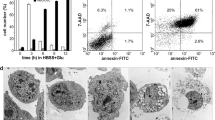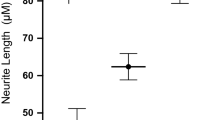Abstract
The implication of β-N-methylamino-L-alanine (BMAA) in the development of neurodegenerative diseases worldwide has led to several investigations of the mechanism, or mechanisms, of toxicity of this cyanobacterially produced amino acid. The primary mechanism of toxicity that was identified is excitotoxicity, with a second possible mechanism, the misincorporation of BMAA into the primary protein structure and consequent cell damage, having been more recently reported. However, studies on excitotoxicity and misincorporation have been conducted independently and there are therefore no data available on the relative contribution of each of these mechanisms to the total toxicity of BMAA. The rat pheochromocytoma cell line PC12 is an ideal model for a study of this type, as glutamate receptor expression is modified by cell differentiation, which can be affected by exposure to nerve growth factor. In this study, the PC12 cell line was evaluated as a model to study BMAA toxicity via the two proposed mechanisms: excitotoxicity and protein misincorporation. BMAA and canavanine treatment of cultures of PC12 were evaluated for depolarization of the mitochondrial membrane. In canavanine-treated cultures, this was evident after 9 days of treatment and was attributed to the primary mechanism of canavanine toxicity, protein misincorporation. However, no membrane depolarization was observed for BMAA-treated cultures even after 21 days of continuous treatment at 500 μM. Short-term exposure to both BMAA and canavanine resulted in a slight increase in necrosis in undifferentiated cells that was prevented in canavanine-treated cultures by co-incubation with arginine, but not in BMAA-treated cultures by co-incubation with serine. A slight increase in apoptosis was observed in undifferentiated cells treated with either BMAA or glutamate, and ROS production increased in glutamate-treated cells. However, the excitotoxicity was less pronounced than reported in previous studies with neuronal cells. In contrast, apoptosis was greatly increased in both BMAA- and glutamate-treated cells after differentiation and resulting mGluR1 increase, indicating that excitotoxicity is the main, if not only, mechanism of toxicity in PC12.






Similar content being viewed by others
References
Arnold A, Edgren DC, Palladino VS (1953) Amyotrophic lateral sclerosis. J Nerv Ment Dis 117:135–139
Brand LE, Pablo J, Compton A, Hammerschlag N, Mash DC (2010) Cyanobacterial blooms and the occurrence of the neurotoxin beta-N-methylamino-ʟ-alanine (BMAA), in South Florida aquatic food webs. Harmful Algae 9:620–635
Casado M, López-Guajardo A, Mellström B, Naranjo JR, Lerma J (1996) Functional N-methyl-D-aspartate receptors in clonal rat phaeochromocytoma cells. J Physiol 490(2):391–404
Chiu AS, Gehringer MM, Braidy N, Guillemin GJ, Welch JH, Neilan BA (2012) Excitotoxic potential of the cyanotoxin β-methyl-amino-L-alanine (BMAA) in primary human neurons. Toxicon 60:1159–1165
Copani A, Canonico PL, Catania MV, Aronica E, Bruno V, Ratti E, Van Amsterdam FTM, Gaviraghi G, Nicoletti F (1991) Interaction between β-N-methylamino-L-alanine and excitatory amino acid receptors in brain slices and neuronal cultures. Brain Res 558:79–86
Cox PA, Banack SA, Murch SJ (2003) Biomagnification of cyanobacterial neurotoxins and neurodegenerative disease among the Chamorro people of Guam. PNAS USA 100(23):13380–13383
Cox PA, Banack SA, Murch SJ, Rasmussen U, Tien G, Bidigare RR, Metcalf JS, Morrison LF, Codd GA, Bergman B (2005) Diverse taxa of cyanobacteria produce β-N-methylamino-ʟ-alanine, a neurotoxic amino acid. PNAS USA 102(14):5074–5078
Cucchiaroni ML, Viscomi MT, Bernardi G, Molinari M, Guatteo E, Mercuri NB (2011) Metabotropic glutamate receptor I mediates the electrophysiological and toxic actions of the cycad derivative β-N-methylamino-L-alanine on substantia nigra pars compacta DAergic neurons. J Neurosci 30(15):5176–5188
Downing S, Banack SA, Metcalf JS, Cox PA, Downing TG (2011) Nitrogen starvation of cyanobacteria results in the production of β-N-methylamino-ʟ-alanine. Toxicon 58:187–194
Dunlop RA, Cox PA, Banack SA, Rodgers KJ (2013) The non-protein amino acid BMAA is misincorporated into human proteins in place of ʟ-serine causing protein misfolding and aggregation. PLoS One 8(9):1–8
Edwards MM, Loxley RA, Williams AJ, Connor M, Phillips JK (2007) Lack of functional expression of NMDA receptors in PC12 cells. Neurotoxicology 28:876–885
Esterhuizen M, Downing TG (2008) β-N-methylamino-ʟ-alanine (BMAA) in novel South African cyanobacterial isolates. Ecotox Environ Safe 71:309–313
Esterhuizen-Londt M, Downing S, Downing TG (2011) Improved sensitivity using liquid chromotagraphy mass spectrometry (LC-MS) for detection of propyl chloroformate derivatized β-N-methylamino-L-alanine (BMAA) in cyanobacteria. Water SA 37(2):133–138
Greene LA, Tischler AS (1976) Establishment of a noradrenergic clonal line of rat adrenal pheochromocytoma cells which respond to nerve growth factor. Proc Natl Acad Sci U S A 73(7):2424–2428
Jonasson S, Eriksson J, Berntzon L, Spáčil Z, Ilag LL, Ronnevi L, Rasmussen U, Bergman B (2010) Transfer of a cyanobacterial neurotoxin within a temperate aquatic ecosystem suggests pathways for human exposure. PNAS 107(20):9252–9257
Kane MD, Vanden Heuvel JP, Isom GE, Schwarz RD (1998) Differential expression of group I metabotropic glutamate receptors (mGluRs) in the rat pheochromocytoma cell line PC12: role of nerve growth factor and ras. Neurosci Lett 252:1–4
Kobayashi S, Millhorn DE (2000) Regulation of N-methyl-D-aspartate receptor expression and N-methyl-D-aspartate-induced cellular response during chronic hypoxia in differentiate rat PC12 cells. Neurosci 101(4):1153–1162
Kurland LK, Mulder DW (1954) Epidemiologic Investigations of Amyotrophic Lateral Sclerosis: 1. Preliminary Report on Geographic Distribution, with Special Reference to the Mariana Islands, Including Clinical and Pathologic Observations. Neurology 4(5):355–378
Liu X, Rush T, Zapata J, Lobner D (2009) β-N-methylamino-L-alanine induces oxidative stress and glutamate release through action on system Xc. Exp Neurol 217:429–433
Liu XQ, Rush T, Ciske J, Lobner D (2010) Selective death of cholinergic neurons induced by beta-methylamino-L-alanine. Neuroreport 21:55–58
Lobner D, Piana PMT, Salous AK, Peoples RW (2007) β-N-methylamino-L-alanine enhances neurotoxicity through multiple mechanisms. Neuorobiol Dis 25(2):360–366
Lopicic S, Nedeljkov V, Cemerikic D (2009) Augmentation and ionic mechanism of effect of β-N-methylamino-L-alanine in presence of bicarbonate on membrane potential of Retzius nerve cells of the leech Haemopis sanguisuga. Comp Biochem Physiol A 153:284–292
Manzoni OJJ, Prezeau L, Bokaert J (1991) β-N-methylamino-L-alanine is a low-affinity agonist of metabotropic glutamate receptors. Neuroreport 2:609–611
Mehmood T, Schneider A, Pannetier S, Hanauer A (2013) Rsk2 knockdown in PC12 cells results in Sp1 dependent increased expression of the Gria2 gene, encoding the AMPA receptor subunit GluR2. J Mol Sci 14:3358–3375
Mondo K, Hammerschlag N, Basile M, Pablo J, Banack SA, Mash DC (2012) Cyanobacterial toxin β-N-methylamino-ʟ-alanine (BMAA) in shark fins. Mar Drugs 10:509–520
Murch SJ, Cox PA, Banack SA (2004a) A mechanism for slow release of biomagnified cyanobacterial neurotoxins and neurodegenerative disease in Guam. PNAS USA 101(33):12228–12231
Murch SJ, Cox PA, Banack SA, Steele JC, Sacks OW (2004b) Occurrence of β-N-methylamino-ʟ-alanine (BMAA) in ALS/PDC patients from Guam. Acta Neurol Scand 110(4):267–269
Myers TG, Nelson SD (1990) Neuroactive carbamate adducts of β-N-methylamino-L-alanine and ethylenediamine. Detection and quantitation under physiological conditions by 13C NMR. J Biol Chem 265:10193–10195
Nunn PB, Ponnusamy M (2009) β-N-methylamino-L-alanine (BMAA): metabolism and metabolic effects in model systems and in neural and other tissues of the rat in vitro. Toxicon 54:85–94
Pai KS, Shankar SK, Ravindranath V (1993) Billionfold difference in the toxic potencies of two excitatory plant amino acids, L-BOAA and L-BMAA: biochemical and morphological studies using mouse brain slices. Neurosci Res 17:241–248
Perreira CMF, Oliveira CR (1997) Glutamate toxicity on a PC12 cell line involves glutathione (GSH) depletion and oxidative stress. Free Radic Biol Med 23(4):637–347
Perreira CMF, Oliveira CR (2000) Oxidative glutamate toxicity involves mitochondrial dysfunction and perturbation of intracellular Ca2+ homeostasis. Neurosci Res 37:227–236
Rao SD, Banack SA, Cox PA, Weiss JH (2006) BMAA selectively injures motor neurons via AMPA/kainate receptor activation. Exp Neurol 201:244–252
Rodgers KJ, Shiozawa N (2008) Misincorporation of amino acid analogues into proteins by biosynthesis. Int J Biochem Cell Biol 40:1452–1466
Ross SM, Seelig M, Spencer PS (1987) Specific antagonism of excitotoxic action of ‘uncommon’ amino acids assayed in organotypic mouse cortical cultures. Brain Res 425:120–127
Scott LL, Downing S, Phelan RR, Downing TG (2014) Environmental modulation of microcystin and β-N-methylamino-L-alanine as a function of nitrogen availability. Toxicon 87:1–5
Sucher NJ, Brose N, Deitcher DL, Awobuluyi M, Gasic GP, Bading H, Cepko CL, Greenberg ME, Jahn R, Heinemann SF, Lipton SA (1993) Expression of endogenous NMDAR1 transcripts without receptor protein suggests post-transcriptional control in PC12 cells. J Biol Chem 268(30):22299–22304
Sudo M, Tsuzuki K, Okado H, Milwa A, Ozawa S (1997) Adenovirus-mediated expression of AMPA-type glutamate receptor channels in PC12 cells. Mol Brain Res 50:91–99
Tanaka H, Grooms SY, Bennett MVL, Zukin S (2000) The AMPAR subunit GluR2: still front and center-stage. Brain Res 886:190–207
Van Onselen R, Cook NA, Phelan RR, Downing TG (2015) Bacteria do not incorporate β-N-methylamino-L-alanine into their proteins. Toxicon 102:55–61
Vega A, Bell EA (1967) α-amino-β-methylaminopropionic acid, a new amino acid from seeds of Cycas circinalis. Phytochemistry 6:759–762
Vega A, Bell EA, Nunn PB (1968) The preparation of L- and D-α-amino-β-methylaminopropionic acid and the identification of the compound isolated form Cycas circinalis as the L-isomer. Phytochemistry 7:1885–1887
Weiss JH, Choi DW (1988) Beta-N-methylamino-L-alanine neurotoxicity: requirement for bicarbonate as a cofactor. Science 241:973–975
Weiss JH, Koh J-Y, Choi DW (1989) Neurotoxicity of β-N-methylamino-L-alanine (BMAA) and β-N-oxylamino-L-alanine (BOAA) on cultured cortical neurons. Brain Res 497:61–71
Zeevalk GD, Nicklas WJ (1989) Acute excitotoxicity in chick retina caused by the unusual amino acids BOAA and BMAA: effects of MK-801 and kynurenate. Neurosci Lett 102:284–290
Acknowledgements
This study was funded by the National Research Foundation of South Africa.
Author information
Authors and Affiliations
Corresponding author
Rights and permissions
About this article
Cite this article
van Onselen, R., Venables, L., van de Venter, M. et al. β-N-Methylamino-L-Alanine Toxicity in PC12: Excitotoxicity vs. Misincorporation. Neurotox Res 33, 15–23 (2018). https://doi.org/10.1007/s12640-017-9743-8
Received:
Revised:
Accepted:
Published:
Issue Date:
DOI: https://doi.org/10.1007/s12640-017-9743-8




